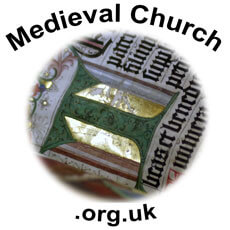Franciscans
Theology on the Web helps over 2.5 million people every year to find high quality theological resources that will help to equip them to serve God and to know Him better (2 Timothy 2:15). Like other websites that provide free services, it is dependent on donations to enable it to grow and develop and only 0.004% of visitors currently do so. If you would like to support this site, please use one of the options to the right of this message.
Synopsis
FRANCISCANS (Minorites, Gray Friars, in England and Ireland, sometimes also the Seraphic Brethren), The Order of the, was founded by St. Francis of Assisi in 1210, and confirmed by Honorius III. in 1223. In the middle of the thirteenth century it had eight thousand monasteries, with two hundred thousand monks.
This extraordinary success was due to various causes. Immediately after his death, the founder of the order was transformed into a kind of divinity in the eyes of the time. The story that Christ had appeared to him on Monte Alberno, and imprinted on his hands and feet the stigmata of the crucifixion, was universally believed. Pope Alexander IV. and St. Clara had seen the marks; Gregory IX., Nicholas III., Benedict XII., Paul V., vouched for the truth. When Bonaventura wrote his life of St. Francis, the most incredible fictions would be easily believed when told of the "seraphic" saints; and in 1399 Bartholomew Albizzi actually instituted a comparison between Christ and St. Francis, in his Liber Conforrnitatum. Of still greater effect were the enormous privileges which the popes granted to the order. Already in. 1222 Honorius III. allowed the Franciscans to celebrate service, though with closed doors, in places which were under the ban. Soon after, they obtained the right to preach wherever they liked without first procuring the consent of the bishop or the parish priest. They were permitted to hear confession, and give absolution; and, in the same year they were constituted as an order, they received the Portiuncula indulgence: that is, every one who visited the Portiuncula Church on the anniversary of its consecration (Aug. 2) received absolution. But, beyond these and other favorable circumstances, the very idea on which the order was based, the very principle on which it worked, corresponded to the deepest wants of the time. Everybody felt that reform was necessary; and the humble, miserable Franciscan, clad in rags, but filled with holy enthusiasm, struck everybody as the reformer.
But success always engenders jealousy; and the Dominicans were the born rivals of the Franciscans. The two orders fought for a time cordially together, side by side, as long as they had a common object; namely, to get access to the universities. But hardly were Bonaventura the Franciscan, and Thomas Aquinas the Dominican, installed as doctores theologiæ at the university of Paris, before a strongly marked scientific difference between the two orders became apparent, and it continued to separate them during the whole period of the middle ages. The Franciscans were realists; the Dominicans, nominalists: the Franciscans leaned towards Semi-Pelagiauism ; the Dominicans were ardent disciples of Augustine: the Franciscans were Scotists; the Dominicans were Thomists: in the debate on the immaculate conception of Mary. the Franciscans said Yes, and the Dominicans, No. But the difference was by no means confined to the sphere of science: it came to many vexatious and sometimes ridiculous outbursts of rivalry between the two orders also in practical life.
Of much greater importance, however, was the difference which arose within the order itself almost immediately after its foundation. The absolute poverty which the founder had ordered seemed to some to be a mere impediment to the success of the order; while by others it was vindicated as the very character of the order. There thus arose two parties, - a milder, headed by Elias of Cortona; and a severer, headed by Caesarius of Spires (see H. RYBKA, Elias con Cortona, Leipzig, 1874); and the contest between these two parties not only threw the order itself into confusion, but at times also involved the Pope and the kings in serious difficulties. Nicholas III. attempted a reconciliation by the bull Exiit, 1279, in which he explained, that though the Franciscans were not allowed to own things, they were, of course. allowed to use things; that the real owner of all the treasures, grounds, buildings, etc., which the order had amassed, was the Pope; and that the members of the order only had the use of these treasures by his permission, etc. This subtle distinction did not satisfy the severer party. Under the leadership of John of Oliva they raised a violent opposition to the bull and to the general of the order, Matthias of Aquas Spartas, who headed the milder party. The latter was victorious, however; and the Spiritualists, as the severer party was called, were cruelly persecuted. Iii Naples they were expelled; and in many places they were seized by the Inquisition, tortured, and burnt. Nevertheless, they continued their resistance, and under John XXII. the strife broke out with renewed vehemence; the general, Michael of Cesena, being this time at the head of the Spiritualists (see E. GIJDENATZ, Michael von Cesena, Breslan, 1876). The result was a permanent split in the order. The Observants, the severer party, were formally recognized by the Council of Constance in its nineteenth sitting (Sept. 23, 1415); and Leo X., after an ineffectual attempt to gather the whole order under one observance, constituted the milder party, the Conventuals, an independent congregation, by a bull of 1517. Each division obtained its own superior; though that of the Observants (the minister generalis) took rank before that of the Conventuals (the magister generals).
In another respect these internal differences contributed much to keep the order alive; and the frequent formation of more or less independent congregations proved the presence of an active principle of development and reform. By the Reformation the order lost heavily, and a great number of its convents were broken up. Nevertheless, at the beginning of the eighteenth century it still numbered about a hundred and fifteen thousand monks; and its monasteries are still flourishing, from the interior of Russia to the interior of America. It has produced five popes (Nicholas IV., Alexander V., Sixtus IV., Sixtus V., and Clement XlV.), a considerable number of theologians (Bonaventura, Alexander of Hales, Ockham, etc.), and of poets, Thomas de Celano, the author of Dies iræ, Jacopone da Todi, the author of Stabat mater, etc.
Zöckler, "Franciscans," Philip Schaff, ed., A Religious Encyclopaedia or Dictionary of Biblical, Historical, Doctrinal, and Practical Theology, 3rd edn, Vol. 2. Toronto, New York & London: Funk & Wagnalls Company, 1894. pp.831-832.
Bibliographies
| Andrew G. Little, A Guide to Franciscan Studies. Helps for Students of History, No.23. London / New York: Society for Promoting Christian Knowledge / The Macmillan Company, 1920. |
Primary Sources
Secondary Sources
Related Subjects
Augustinians | Carmelites | Dominicans | Franciscans | Servites
 |
|
 |
|
 |





![William John Knox Little [1839-1918], St. Francis of Assisi](images/books3/st-francis-and-assisi_little-tb.jpg) William John Knox Little [1839-1918], St. Francis of Assisi. his Times Life and Work. Lectures Delivered in Sustance in the Ladye Chapel of Worchester in the Lent of 1896. London: Isbister and Company Limited, 1897. Hbk. pp.328.
William John Knox Little [1839-1918], St. Francis of Assisi. his Times Life and Work. Lectures Delivered in Sustance in the Ladye Chapel of Worchester in the Lent of 1896. London: Isbister and Company Limited, 1897. Hbk. pp.328.  F. Donald Logan, A History of the Church
in the Middle Ages. London & New York: Routledge, 2002. Pbk. ISBN:
0415132894. pp.213-220.
F. Donald Logan, A History of the Church
in the Middle Ages. London & New York: Routledge, 2002. Pbk. ISBN:
0415132894. pp.213-220. Patrick Nold, Pope John XXII and His Franciscan
Cardinal: Bertrand De La Tour and the Apostolic Poverty Controversy. Oxford
Historical Monographs. Oxford: Clarendon Press, 2003. Hbk. ISBN: 0199268754.
pp.280.
Patrick Nold, Pope John XXII and His Franciscan
Cardinal: Bertrand De La Tour and the Apostolic Poverty Controversy. Oxford
Historical Monographs. Oxford: Clarendon Press, 2003. Hbk. ISBN: 0199268754.
pp.280. G.S.M. Walker, The Growing Storm. Sketches of Church History from A.D. 600 to A.D. 1350. London: The Paternoster Press, 1961. Hbk. pp.252.
G.S.M. Walker, The Growing Storm. Sketches of Church History from A.D. 600 to A.D. 1350. London: The Paternoster Press, 1961. Hbk. pp.252. 


